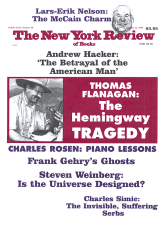In response to:
The Mystery of Emily Dickinson from the April 8, 1999 issue
To the Editors:
Christopher Benfey begins his thoughtful if reductive review [NYR, April 8] of The Poems of Emily Dickinson: Variorum Edition, edited by Ralph Franklin; Open Me Carefully: Emily Dickinson’s Intimate Letters to Susan Huntington Dickinson, edited by Ellen Louise Hart and Martha Nell Smith; and The Emily Dickinson Handbook, edited by Grabher, Hagenbüchle, and Miller, by citing lines from “The Scholars” (1919), a poem by W.B. Yeats. In it Yeats shows the ironic contrast between passionate young men who are poets and scholarly old men, “Bald heads forgetful of their sins/Old, learned, respectable bald heads—,” who become their editors. Benfey wittily reverses characters. When it comes to the history of publishing Emily Dickinson’s poems all of her editors, “tossing on their beds,/Rhym[ing] out in love’s despair,” seem destined to assume the poet position. He worries that disagreements, referred to here as “squabbles,” will intensify in the wake of Franklin’s careful work on the new variorum. Would he have used the term to refer to editorial disagreements over the publication of male authors? Benfey’s tone of sarcasm belittles an impassioned living interest: the vital urgency in current debates over textual production and authority where feminist theory, writing technologies, and textual practice intersect.
Although Franklin’s 1998 variorum involves the transformation of a material document into an immaterial text, the deepest connection to Thomas H. Johnson’s earlier 1955 edition is the privileging of the features of the linguistic text over the characteristics of the fascicles themselves. When it comes to physical line breaks on the page both Johnson and Franklin virtually ignore, among other details, the poet’s original lineation. This privileging of the aural over spatial qualities in poetry blurs Dickinson’s sense of the poem as a pictorial unit (a sense she shares with Marianne Moore and William Carlos Williams). Paradoxically the value of The Poems of Emily Dickinson: Variorum Edition, with its emphasis on the fluid boundaries between manuscript versions and their relation to the published text, coming at a time when the evolution of electronic technologies is suggesting possible new forms of textual reproduction and presentation, embodies (perhaps in spite of itself) a hyper-awareness of the wide range of approaches and premises currently at play in the theory and practice of text editing. In editorial controversies concerning these infinitely complex manuscripts we will find accommodation unaccommodation, diversity, but the conversation is an education we cannot do without. It is a relation between the imagination and reality.
When Benfey tells us he is afraid “the end result of technological innovations in transcription will be to make a poet already regarded as eccentric even more so,” I can only counter with lines by Wallace Stevens from “A Primitive Like an Orb.”
That’s it. The lover writes, the believer hears,
The Poet mumbles and the painter sees,
Each one, his fated eccentricity,
As a part, but part, but tenacious particle,
Of the skeleton of the ether, the total
Of letters, prophesies, perceptions, clods
Of color, the giant of nothingness, each one
And the giant ever changing, living in change.
Susan Howe
Professor of English
State University of New York at Buffalo
Christopher Benfey replies:
Susan Howe’s question about “squabbles” is meant to be rhetorical, but of course the answer is yes. I would have used the same term if the author were male. But I am struck as much by the consistency over time of Dickinson’s line breaks and stanza forms as by her modifications. I see the appeal of regarding Dickinson as in some sense anticipating Williams and Moore in fracturing the iambic line. But the evidence, as I argued in my piece, is tenuous. And whatever experiments she may have indulged in cannot have meant the same thing during the 1860s as what Williams and Moore were up to during the 1920s. Did Dickinson have a “sense of the poem as a pictorial unit”? I don’t think so. I would argue, instead, that her sense of meter and stanza was so secure that she didn’t worry overmuch about how the poem was broken up on the narrow sheets and scraps of paper she often used. The lines from Stevens, if we accept them to be a simple description of poets (which I doubt), encourage precisely the sort of patronizing of poetic eccentricities that I was out to deflect from Emily Dickinson.
This Issue
October 21, 1999



